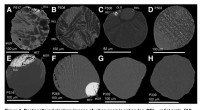
Wetenschap
Staten pakken PFAS forever-chemicaliën aan met verboden, rechtszaken

Krediet:Pixabay/CC0 publiek domein
"Voor altijd chemicaliën" zijn overal. De duizenden chemicaliën in de groep die bekend staat als perfluoralkyl- en polyfluoralkylstoffen, of PFAS, worden aangetroffen in kookgerei, verpakkingen, cosmetica, kleding, tapijt, elektronica, blusschuim en vele andere producten.
De chemicaliën, die van nature niet afbreken, zijn zo wijdverbreid dat ze in het bloed van 97% van de Amerikanen worden aangetroffen. Onderzoek toont aan dat sommige PFAS-verbindingen de vruchtbaarheid kunnen verminderen, stofwisselingsstoornissen kunnen veroorzaken, het immuunsysteem kunnen beschadigen en het risico op kanker kunnen verhogen.
Terwijl staten wachten op regelgeving van de federale Environmental Protection Agency, heeft het toenemende bewustzijn in de afgelopen jaren meer dan twee dozijn staten ertoe aangezet het initiatief te nemen om de gezondheid van hun inwoners te beschermen, in veel gevallen door middel van tweeledige wetgeving.
Sommigen hebben het gebruik van PFAS in bepaalde consumentenproducten verboden. Anderen hebben strengere waterkwaliteitsnormen uitgevaardigd of overheidsinstanties gemachtigd om de regelgeving te versnellen. Velen streven naar opruimings- en saneringsinspanningen, waarbij staten vervuilers aanklagen voor compensatie variërend van tientallen miljoenen tot bijna een miljard dollar. En naarmate meer instanties en wetgevers geïnteresseerd raken en beginnen met het testen op PFAS, zeggen experts dat er meer veranderingen zullen komen.
"De interesse en actie nemen alleen maar toe", zegt Sarah Doll, nationaal directeur van Safer States, een alliantie van milieu-gezondheidsgroepen die zich richten op giftige chemicaliën. "Meer overheidsinstanties zoeken en vinden PFAS in water, slib en de lucht. Het groeit en ik verwacht absoluut dat het in 2023 allemaal beleidssessies zal zijn."
Doll's groep heeft 203 wetsvoorstellen gevolgd die zijn voorgesteld in 31 staten met betrekking tot PFAS-kwesties.
"Ik heb van wetgevers gehoord dat testen een drijvende kracht voor hen is geweest", zegt Mara Herman, manager milieugezondheid bij de National Caucus of Environmental Legislators, een forum voor staatswetgevers. "Het wordt op zoveel plaatsen gevonden, het is niet echt een stedelijk probleem of een landelijk probleem."
Toch blijft de lappendeken van wetten en rechtszaken ongelijk, en voorstanders zeggen dat Amerikanen federale actie nodig hebben om multinationale bedrijven verantwoordelijk te houden voor verontreiniging in het verleden, de waterwegen en systemen die nu geïnfecteerd zijn schoon te maken en een ingrijpend verbod op te leggen op het gebruik van PFAS in nieuwe producten.
"Staat voor staat is gewoon absoluut belachelijk", zegt Laurene Allen, mede-oprichter van Merrimack Citizens for Clean Water, een groep uit New Hampshire die de staat ertoe heeft aangezet om op te treden tegen PFAS. "De voortgang die je hebt, zou niet moeten worden bepaald door je postcode."
De EPA heeft een regel voorgesteld om twee veel voorkomende PFAS-chemicaliën onder de Superfund-wet te reguleren, maar het agentschap heeft nog niet om openbaar commentaar gevraagd, wat nodig is voordat de regel van kracht kan worden.
Voorstanders van de industrie lobbyen ondertussen op federaal niveau en in staatshuizen, met het argument dat pogingen om PFAS in grote lijnen te reguleren, uiteindelijk zouden kunnen leiden tot een verbod op onschadelijke chemicaliën die cruciaal zijn voor belangrijke producten en industrieën. PFAS-verbindingen werden lange tijd gezien als een chemisch "wonder" vanwege de eigenschappen die ze anti-aanbak, vlekafstotend, waterdicht of brandwerend maakten.
"Alle PFAS zijn niet hetzelfde en ze zouden niet op dezelfde manier moeten worden gereguleerd", zei de American Chemistry Council in een verklaring van Tom Flanagin, senior directeur productcommunicatie. "De meest problematische wetgeving omvat ongepaste en te brede definities van PFAS die veel potentieel onbedoelde stoffen en producten binnenhalen."
Flanagin's e-mail noemde een categorie fluorpolymeren die worden gebruikt in hernieuwbare energie, gezondheidszorg, elektronica en andere industrieën als essentieel voor veel producten terwijl ze een laag veiligheidsrisico met zich meebrengen.
PFAS-verboden
Wetgevers in verschillende staten wijzen op de goedkeuring van Maine in 2021 van een wet die PFAS verbiedt in alle nieuwe producten als een mijlpaal.
De maatregel, die in 2030 van kracht wordt, verbiedt elke opzettelijk toegevoegde PFAS, maar laat uitzonderingen toe in producten die essentieel zijn voor de gezondheid, veiligheid of het functioneren van de samenleving en die nog geen PFAS-vrij alternatief hebben.
"Ik maakte me echt zorgen toen ik hoorde dat PFAS in vrijwel alles voorkomt", zei staatsvertegenwoordiger Lori Gramlich, de democraat die het verbod steunde. "Toen ik me meer bewust werd van hoe wijdverbreid dit probleem was, dacht ik:'We moeten iets doen.'"
Weinig of geen staten hebben een PFAS-verbod aangenomen dat zo ingrijpend is als dat van Maine, maar velen hebben wetten uitgevaardigd die gericht zijn op PFAS in voedselverpakkingen, cosmetica, blusschuim of textiel. Colorado heeft eerder dit jaar een wet aangenomen die betrekking heeft op veel producten, terwijl het gebruik ervan in de olie- en gasproductie ook wordt stopgezet. Staatsvertegenwoordiger Mary Bradfield, een Republikein die het wetsvoorstel mede heeft gesponsord, zei dat ze moest optreden toen drie waterdistricten in haar gemeenschap worstelden met PFAS-besmetting van de nabijgelegen Peterson Air Force Base.
"PFAS-chemicaliën verschijnen in alarmerende hoeveelheden", zei Bradfield. "In certain concentrations, it can be very detrimental to health. My bill targets those products where there is a viable substitution for PFAS."
Bradfield said other lawmakers wanted to pursue an economy-wide ban as broad as Maine's, but she felt the targeted approach—which includes carpets and rugs, food packaging and children's products—was more achievable.
In Hawaii, legislators passed a ban on PFAS in food packaging and firefighting foam earlier this year. State Rep. Nicole Lowen, a Democrat who co-sponsored the bill, said it was backed by research that showed alternative products already exist on the market, adding that the "writing is on the wall" for other PFAS categories.
"We felt like that would be the politically easiest thing to move forward," she said. "From everything I've learned, unless there's some need that cannot be replaced by anything else we have, these need to be phased out from use, period."
Meanwhile, California passed laws this year to ban PFAS in cosmetics and textiles, while requiring companies to report data on other products containing PFAS.
Agency action
Some lawmakers have focused their efforts on empowering state regulators, rather than targeting specific products.
In Washington, legislators passed a law earlier this year that will allow the state Department of Ecology to issue PFAS regulations within three years, instead of the 2030 timeline under the previous regulatory structure. That agency, which will have the authority to issue bans on PFAS in certain products, is expected to act by 2025, giving Washington the fastest timeline in the nation for phasing out PFAS.
"It's the government's job to protect people," said state Rep. Liz Berry, a Democrat who sponsored the bill. "[The agency] has done a lot of the homework already. It's just a matter of pulling the trigger."
In some states, agency officials have led the response to PFAS contamination. In Michigan, for example, regulators crafted rules over the past several years for levels of some PFAS compounds in drinking water, groundwater and surface water. The state also brought together seven state agencies to form the Michigan PFAS Action Response Team, known as MPART, which serves as a coordinating group for testing, cleanup and public education efforts. The state has conducted extensive testing to identify contaminated sites.
"The biggest threat to public health has been around water quality," said Abigail Hendershott, MPART's executive director. "If we've got a source [of contamination], we're going to find it in groundwater, so that's the easiest way to define and start those compliance actions."
Now that it has a better handle on testing and regulating water, the state may turn its attention to consumer products, she said.
Cleaning up
Banning products and setting regulations may help prevent future contamination. But states still have much work ahead to address the forever chemicals found in their water, soil and residents.
Earlier this year, Florida legislators passed a bill requiring the state's Department of Environmental Protection to establish rules by 2025 for target cleanup levels of PFAS if the EPA has not set a national standard by then. State Rep. Toby Overdorf, a Republican who co-sponsored the bill, said his community in Stuart, Florida, has had wells contaminated by PFAS. He noted the massive expense to clean up contaminated water systems.
"There will be state, federal and local funding that will need to come into play to address the problem," he said. "We are going to be educating municipalities and letting them know they need to develop a plan to get a hold of this so they can deliver clean drinking water."
New Hampshire set aside $25 million earlier this year to bolster a loan fund for PFAS remediation of public water systems and wastewater facilities. And lawmakers in Vermont gave residents the right to sue chemical companies for medical monitoring costs if they've been exposed to PFAS.
Meanwhile, 15 state attorneys general separately have sued companies alleged to be responsible for PFAS contamination, seeking damages for the harm caused by the pollution. Minnesota settled with 3M Company, which produced nonstick chemicals that polluted groundwater in the Twin Cities area, for $850 million in 2018. Delaware also reached a settlement, but the other lawsuits are still ongoing.
"It costs tens of millions of dollars to remediate PFAS from water and sewer facilities," said Jon Groveman, policy and water program director at the research and advocacy group Vermont Natural Resources Council. "It's either going to come from taxpayers or the citizens who pay water and sewer bills. AGs are saying, 'No, that's not fair.'"
Vermont recently passed a law creating a legal cause of action against manufacturers of hazardous materials who cause harm, without needing to prove negligence. Other states seeking to sue PFAS manufacturers may pursue similar legislation, Groveman said.
But some industry leaders think it's unfair to hold PFAS manufacturers accountable for every instance of contamination.
"It's not the person who manufactured it who caused the spill or leak, it's the person on whose property the leak occurred," said Scott Manley, executive vice president of Wisconsin Manufacturers &Commerce, a pro-business lobbying association.
The group opposes a lawsuit brought by Gov. Tony Evers and Attorney General Josh Kaul, both Democrats, seeking nearly $1 billion from 18 companies state leaders say failed to protect the public.
Manley noted that his group has supported efforts to create a grant funding program to help local governments deal with PFAS hotspots.
But in some states, leaders would rather see polluters than taxpayers pay for cleanup.
"These chemicals are very difficult to clean up, and it's very expensive," said Minnesota state Rep. Ami Wazlawik, a Democrat who sponsored a bill that banned PFAS in food packaging. "The taxpayers of Minnesota are not responsible for putting these chemicals there." + Verder verkennen
High levels of PFAS detected in school uniforms
2022 The Pew Charitable Trusts.
Distributed by Tribune Content Agency, LLC.
 Afbeelding:Balatonmeer in het westen van Hongarije vanuit een baan om de aarde
Afbeelding:Balatonmeer in het westen van Hongarije vanuit een baan om de aarde De voordelen van het updaten van de agrarische drainage-infrastructuur
De voordelen van het updaten van de agrarische drainage-infrastructuur Sterke Indiase moessons sturen Atlantische orkanen naar land, studie vondsten
Sterke Indiase moessons sturen Atlantische orkanen naar land, studie vondsten Toekomstige overstromingen van de Brahmaputra-rivier als klimaatveranderingen kunnen worden onderschat, studie zegt:
Toekomstige overstromingen van de Brahmaputra-rivier als klimaatveranderingen kunnen worden onderschat, studie zegt: De bijtende insecten en insecten gevonden in North Carolina
De bijtende insecten en insecten gevonden in North Carolina
Hoofdlijnen
- Hoe meet je geluk?
- Zwemmers jeuk:wat veroorzaakt deze verwaarloosde door slakken overgedragen ziekte?
- Spiegelbeeldmoleculen onthullen droogtestress in bossen
- Hoe SARS werkt
- Monster ontdekt in het Canadese Noordpoolgebied
- Waarom is het zo moeilijk voor soorten om hun ecologische niche te verlaten?
- Droogteresistente plantengenen kunnen de evolutie van waterbesparende gewassen versnellen
- Nestgebieden van schildpadden volgen
- Klimaatveranderingen verkorten de mariene voedselketen voor de kust van Californië
- Droogte verhoogt de uitstoot als waterkracht opdroogt

- Onderzoekers presenteren een nieuwe synthetische kijk op de topografische evolutie van Tibet

- Hoe slimme monitoring een stadsboerderij helpt floreren

- Waarom natuurgebieden hun potentieel niet waarmaken in Indonesië

- Een stedelijke verzameling moderne micrometeorieten

 Nieuwe technologie voor de productie van vliegtuigstructuren heeft hun kracht vergroot
Nieuwe technologie voor de productie van vliegtuigstructuren heeft hun kracht vergroot In de EU, ruimteverwarming is verantwoordelijk voor het grootste deel van het huishoudelijk energieverbruik
In de EU, ruimteverwarming is verantwoordelijk voor het grootste deel van het huishoudelijk energieverbruik Moleculaire zeven activeren
Moleculaire zeven activeren  Wiskundigen stellen voor om draadloze energie uit te wisselen voor gegevens die zijn verzameld door sensoren op mobiele apparaten
Wiskundigen stellen voor om draadloze energie uit te wisselen voor gegevens die zijn verzameld door sensoren op mobiele apparaten Nieuwe studie toont verlies van de West-Antarctische ijskap in de afgelopen 11, 000 jaar
Nieuwe studie toont verlies van de West-Antarctische ijskap in de afgelopen 11, 000 jaar Stenen werktuigen onthullen moderne mensachtige grijpmogelijkheden 500, 000 jaar geleden
Stenen werktuigen onthullen moderne mensachtige grijpmogelijkheden 500, 000 jaar geleden Lepra-DNA geëxtraheerd uit middeleeuwse skeletten in Denemarken
Lepra-DNA geëxtraheerd uit middeleeuwse skeletten in Denemarken Risicotool voor klimaatverandering om voor het eerst de impact op kinderen te beoordelen
Risicotool voor klimaatverandering om voor het eerst de impact op kinderen te beoordelen
- Elektronica
- Biologie
- Zonsverduistering
- Wiskunde
- French | Italian | Spanish | Portuguese | Swedish | German | Dutch | Danish | Norway |

-
Wetenschap © https://nl.scienceaq.com

